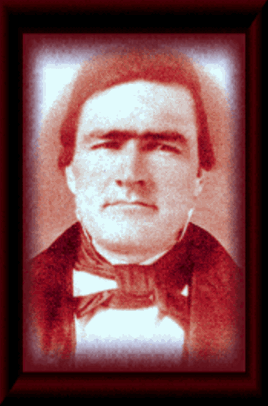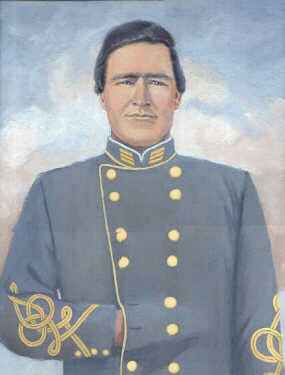|
Captain George W. Stump
Please be patient, some images may take time to load!
Captain George W. Stump of company B was one ot the most active mambers of the 18th Virginia Cavalry. At the organization of company B he had provided at his own expense the horses and much of the equipment for his troop. His command nicknamed him "Stump's Battery" because he always carried several revolvers and a carbine. He had been active during the war in raiding Union outposts. In addition, he and his company joined McNeill's Rangers on several occasions in attacks on the Union forces in northwestern Virginia. A severe neck wound he had received at the engagement at Forrestville on September 24 had necessitated a lengthy recovery. He was cared for in Rockingham County until the presence of Union cavalry in the area forced him to seek safety in western Virginia.
Captain Stump rejoined his command early in 1865, but was still suffering greatly from his wound. Early in the morning of February 5, he stopped to visit his father who was living near Romney in Hampshire County. He had just reached the porch of the house when he heard unfamiliar voices coming from the other side of the house. The voices he heard belonged to members of a Union force led by Major Henry Young which had been dispatched on a mission to capture Major Harry Gilmor at Moorefield. Major Young had left Winchester early in the morning of February 4, with 300 men of the 1st Connecticut Cavalry. When they reached Hampshire County they learned that Captain Stump was in the vicinity. They determined to capture him before continuing on in search of Major Gilmor. It was a portion of this Union force whose voices Captain Stump heard on that morning of February 5.
Stump realized he was in danger so he made his way back across the yard to where his horse was tied. As he was mounting his horse, the Union troops discovered his presence and fired on him, knocking his horse down. As the horse dropped, Stump fell onto the frozen ground. As he attempted to rise, one of the Federals shot him in the side. They then put him on a horse and rode off with him in tow. Now suffering with two serious wounds, he soon became too ill to ride. When this fact was relayed to Major Young his terse comment was: remake him sicker." He was shot several times and left dead in the road. His body was later removed by his brother Even the Union soldiers later remarked that they considered his killing to be murder, rather than an act of war.
In the middle on the night, Gilmor and his cousin, Hoffman, were rudely awakened by armed scouts and escorted back to Winchester. Gilmor was taken to Fort Warren, in Boston Harbor, where he was confined for the remainder of the war. The Jessie Scouts had completed another successful operation. They eliminated another threat on the outbound leg of the trip to capture Gilmor. Having located the home of Captain George Stump's father, the scouts stopped and were able to capture Stump. He apparently resisted capture or attempted to escape. There are three separate accounts of this episode in the war, but regardless of the account, the results were the same. George Stump was shot dead. This must have occurred on the ride to capture Gilmor, as Gilmor makes no mention of the killing of Stump. Another captive of the Jessie Scouts, George Opie, described Stump's body, blackened and frozen beside the road, as he was taken into captivity. Stump was a serious secessionist who had sworn that he would never be taken alive. While the actual story of his death remains unknown, it is likely that he challenged the Jessie Scouts to a duel and lost. He was normally so heavily armed that his own men referred to him as "Stump's Battery," but his weapons didn't save him. There is a report that the Jessie Scouts told Major Young that Stump was sick, too sick to ride and Young replied, "Make him sicker!" Another report exists that Stump tried to take a pistol from a guard while they were riding along and Young warned him that he would be shot if he made another similar attempt. Stump made another try to snatch a pistol, this time the one belonging to Young, who ordered his men, simply, "Plug him!" It is equally likely that the pugnacious Stump challenged the scouts to a duel and died in it.
|
 |  You may contact Tim at caycarsullivan@aol.com |
|
Romney, W.VA. The small stone building to the right of the house is the fort used during the French and Indian wars.
To view a larger painting just click on this painting. |